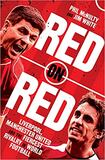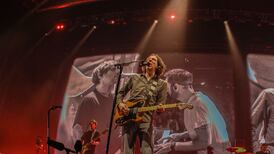
During April 2014 the bridge at Cabra commemorating Busby Babe Liam Whelan was defaced with graffiti about the Munich air crash in which he died. Those who painted the slogans identified themselves as supporters of Liverpool FC. Aside from the stupidity of the act (Irish followers of an English team mocking the death of an Irish international in the area in which his family still live), the incident illustrated how the rivalry between England’s two biggest clubs has long unleashed toxicity.
Red on Red tells that story from multiple angles, interviewing players and commentators and, most importantly, fans, including those at the cutting edge of terrace culture. Its cognisance of social and political contexts shows a debt to Two Tribes, Tony Evans’s classic study of Merseyside football.
The assertion that this the fiercest rivalry in world football may raise some eyebrows. Is it actually fiercer than Celtic/Rangers or Barcelona/Real Madrid? Or even really any more venomous than Bohemians and Shamrock Rovers? All football rivalries are “fierce”; all depend on the ability of otherwise rational people to vocalise things for 90 minutes that they would not dream of saying in everyday life.
What marks out the Manc/Scouse divide is its global nature; it is a game that matters in Cork, Oslo and Kuala Lumpur as much as in Collyhurst and Huyton. Liverpool and United have been transnational entities for some time, but both crucially maintain core support in their native cities that gives their enmity at least some of its intensity. Despite many similarities, with Irish immigration shaping the character of both places and neither club’s core support caring much for the England national team, Manchester and Liverpool have long been rivals.
GP and author Claire Gleeson: ‘I have dealt with patients who lose complete touch with reality’
TV guide: the best new shows to watch, starting tonight
‘My partner broke up with me to ‘find himself’ – but still texts me every day’
An Irish doctor on why she believes autism, ADHD and depression are being overdiagnosed
Though racism existed among both clubs support, unlike at many other English grounds the far-right never gained an appreciable foothold at either Anfield or Old Trafford
Although the authors interrogate the historical roots of this, most modern supporters frankly know little and care less about the construction of the Manchester Ship Canal. Then why the hatred? While Liverpool may once have been (allegedly) a “Protestant” club and United had a very Catholic image until the 1970s, that is not an issue now. There are as many supporters of both clubs on Belfast’s Shankill Road as there is on the Falls. Nor is the divide political. Though some may imagine Liverpool the socialist opposition to “Tory Tory Man United”, the reality is messier.
When before the most recent contest involving the two, United fans demonstrated against their club’s owners, Liverpool fans chanted in support of the Florida-based billionaire Glazers. As usual with this fixture, rivalry trumped class solidarity. But in a football world in which money speaks loudest, there has not been a direct transfer between the two since 1964. In that decade, though, United manager Matt Busby (a former Liverpool captain) was famously close to his Anfield counterpart Bill Shankly, and both clubs disliked Leeds far more than each other.
All that changed in the 1970s. Liverpool fans felt their clubs successes were downplayed by a Manchester-based media still obsessed with the “glams” of Old Trafford despite United’s decline. United supporters thought Liverpool’s faux humility masked arrogance while the popular eulogization of Liverpool fans ignored a more violent reality.
Though both cities suffered under Thatcher’s administrations, it was Merseyside that became a centre of resistance to Tory rule. The success of Liverpool (and Everton) instilled pride in a region that felt itself beset. United fans in contrast embraced malign stereotypes of Scousers that came straight from the tabloid playbook.
The book does not shy away from how revelling in each other’s tragedies has often defined relations between the clubs. Since Liverpool’s modern ethos has been so shaped by the horror of Hillsborough it is sometimes forgotten how their fans once led the way in celebrating the Munich disaster. The book implies that after 1989 these songs largely ceased, but this is sadly not true. The 21st century has seen Liverpool supporters lauding serial killer Harold Shipman (”he only killed Mancs”) while a poisonous subculture among United fans regularly embarrasses themselves by singing the praises of The Sun newspaper.
Though racism existed among both clubs support, unlike at many other English grounds the far-right never gained an appreciable foothold at either Anfield or Old Trafford. Nevertheless, the comments by a former Liverpool hooligan that one way of recognising their opposite numbers (given that both sides dressed similarly) was that United had “black lads” while Liverpool did not shows that this subject might have been worth investigating further.
Though featuring enough vignettes about significant fixtures to satisfy any football obsessive, Red on Red also illustrates why in the words of the (typically self-reverential) Liverpool slogan, this is really a rivalry that “means more”.










